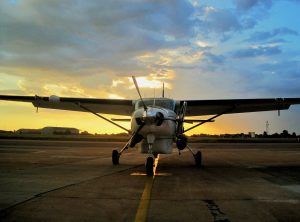
When researching propeller airplanes, you may come across the term “feathering.” It’s commonly used when turboprop engines fail. Turboprop engines are a type of gas turbine engine that turns a propeller blade. When they fail, pilots will often feather the airplane to reduce drag and adverse yaw. To learn more about feathering and how it works, keep reading.
The Basics of Feathering
Feathering is the process of aligning the blades of a failed turboprop engine so that they are aligned with the direction of the airflow. When a turboprop engine fails, the propeller to which it’s connected will keep spinning. Air will continue to flow past the propeller, thereby spinning it. This spinning action creates drag and makes the airplane harder to control. Feathering, however, allows pilots to adjust the blades so that they match the airflow.
How Feathering Works
Feathering is only available for variable-pitch propeller airplanes. As their name suggests, variable-pitch propeller airplanes support pitch adjustment. Pilots can adjust the pitch of the propeller blades, which is the distance a propeller blade moves in a single 360-degree revolution.
Propeller blades are typically angled so that they bite into the air. This helps to maximize thrust by propelling the airplane forward. When an engine fails, the propeller will continue to spin as air moves past it. But without the engine running, it won’t produce thrust. Instead, it will create resistance that slows the airplane down. Feathering counters the effects of a failed engine by aligning the blades so that they match the direction of the airflow.
Pilots can feather the airplane’s propeller blades via a control lever. Engaging this control lever will change the angle of the propeller. With that said, some airplanes have an automatic feathering system. They are designed to adjust the angle of the propeller automatically if the engine fails.
When Do Pilots Use Feathering?
Pilots may use feathering in several scenarios, one of the most common being engine failure. Turboprop engines can fail just like their turbofan counterparts. To minimize drag when a turboprop engine fails, pilots may feather it.
In-flight emergencies may prompt pilots to use feathering. Emergencies can occur during takeoffs and landings, for instance. Even if the engine hasn’t completely failed, it may require feathering to minimize drag.
Finally, pilots may use feathering during training. Pilots must train for all types of scenarios, including engine failure. By familiarizing themselves with feathering, pilots can better prepare themselves for real-world scenarios of engine failure.



